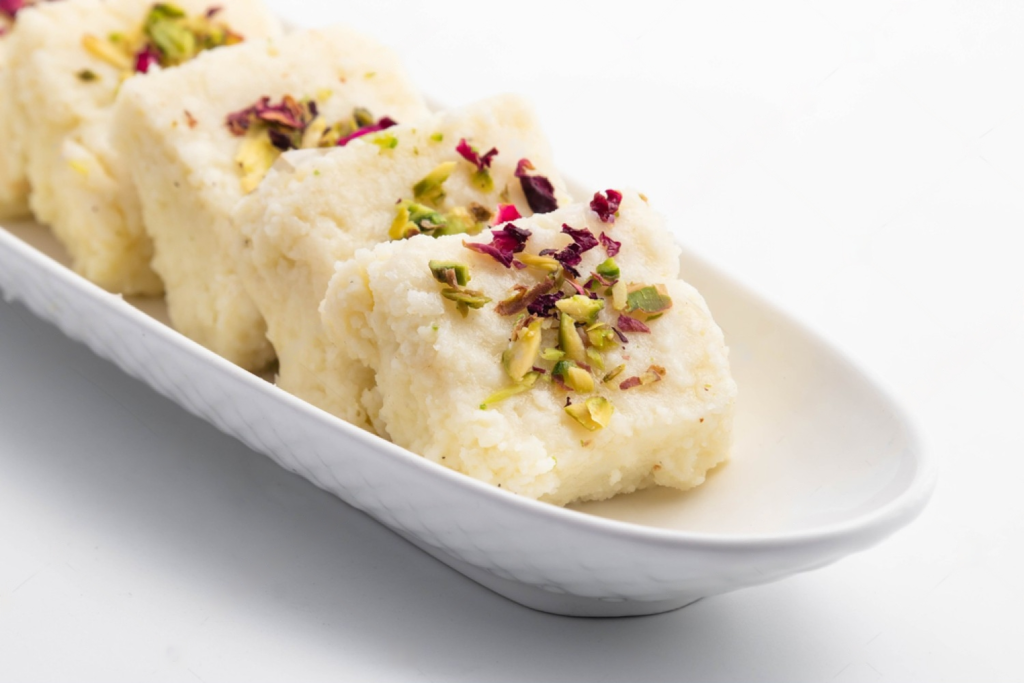
Kalakand: A Celebrated Indian Sweet Delicacy
Kalakand, a deliciously rich and creamy milk-based sweet, is a hallmark of Indian confectionery. Known for its grainy texture and melt-in-the-mouth goodness, kalakand holds a special place in Indian festivals, celebrations, and even everyday indulgences. This article delves into the history, preparation, cultural significance, and variations of this delectable sweet.
Historical Background
Kalakand, also known as “Indian milk cake,” has its origins in the Indian subcontinent. It is believed to have been invented in the town of Alwar in Rajasthan by Baba Thakur Das. This sweet soon gained popularity and spread to other parts of India. The key ingredient, milk, has been a staple in Indian cuisine for centuries, revered not just for its nutritional value but also for its versatility in creating a myriad of desserts. Kalakand stands out among these desserts for its simplicity and exquisite taste.
The Art of Preparation
The traditional method of making kalakand is a labor-intensive process that requires patience and skill. The primary ingredients are milk, sugar, and paneer (Indian cottage cheese). Here’s a step-by-step guide to preparing kalakand:
-
- Boiling the Milk: The process begins with boiling full-fat milk in a wide, heavy-bottomed pan. The milk is boiled until it reduces to about half its original volume.
-
- Adding Paneer: Once the milk thickens, fresh paneer is added. Paneer can be made by curdling milk with a few drops of lemon juice or vinegar. The curdled milk is then strained to remove excess water, leaving behind soft, crumbly paneer.
-
- Cooking and Stirring: The mixture of reduced milk and paneer is cooked further on low heat. Continuous stirring is crucial to prevent it from sticking to the bottom of the pan and to achieve the desired grainy texture.
-
- Sweetening: Sugar is added to the mixture, and it is cooked until the mixture thickens further and leaves the sides of the pan. The sugar not only sweetens the kalakand but also helps in binding the mixture.
-
- Setting the Kalakand: The thickened mixture is poured into a greased tray and spread evenly. It is then allowed to cool and set. Once set, it is cut into squares or diamond shapes.
-
- Garnishing: Kalakand is often garnished with slivers of almonds and pistachios, adding a touch of crunch and enhancing its visual appeal. A sprinkle of cardamom powder adds a fragrant note to the sweet.
Cultural Significance
Kalakand is a popular sweet during Indian festivals such as Diwali, Holi, and Raksha Bandhan. It is often prepared at home or bought from sweet shops to celebrate these joyous occasions. In many households, offering kalakand to guests is a gesture of hospitality and warmth.
Apart from festivals, kalakand is also a preferred choice for offerings in temples and during religious ceremonies. Its rich taste and texture make it a fitting offering to deities. In some regions, it is also customary to include kalakand in wedding feasts and other significant family celebrations.
Regional Variations
While the basic ingredients and method of preparation remain largely the same, different regions in India have put their unique spin on kalakand. Here are some notable variations:
-
- Alwar Kalakand: Originating from Alwar in Rajasthan, this variation is known for its slightly brownish color and intense flavor, achieved by cooking the mixture longer to caramelize the milk solids.
-
- Milk Kalakand: In this variation, an additional amount of condensed milk or khoya (milk solids) is added to the mixture, making it richer and creamier.
-
- Fruit Kalakand: Some recipes incorporate fruit purees, such as mango or pineapple, into the kalakand mixture, lending a fruity twist to the traditional sweet.
-
- Chocolate Kalakand: A modern twist to the classic, chocolate kalakand includes cocoa powder or melted chocolate, making it a favorite among the younger generation.
-
- Rose Kalakand: Infused with rose water and garnished with rose petals, this variation has a delicate floral aroma and taste.
Nutritional Value
Kalakand is not just a treat for the taste buds; it also offers some nutritional benefits. Being a dairy-based sweet, it is a good source of calcium and protein. The paneer in kalakand provides essential amino acids, while the nuts used for garnishing add healthy fats, vitamins, and minerals. However, due to its high sugar content, kalakand should be enjoyed in moderation, especially by those monitoring their sugar intake.
Modern Adaptations
With the rise of health-conscious eating, there have been several adaptations of kalakand to cater to different dietary needs. Some of these include:
-
- Sugar-Free Kalakand: Using natural sweeteners like stevia or erythritol, sugar-free versions of kalakand are becoming popular among those looking to reduce their sugar intake without compromising on taste.
-
- Vegan Kalakand: For those following a vegan lifestyle, traditional dairy ingredients are substituted with plant-based alternatives. Coconut milk or almond milk can replace cow’s milk, and tofu or cashew cheese can be used instead of paneer.
-
- Low-Fat Kalakand: To make a lighter version, low-fat or skimmed milk can be used, and the amount of sugar can be reduced.
Conclusion
Kalakand, with its rich history, cultural significance, and delightful taste, continues to be a beloved sweet in Indian households and celebrations. Its versatility in preparation and ability to adapt to modern dietary preferences ensures that it remains relevant and cherished. Whether enjoyed in its traditional form or with a contemporary twist, kalakand is a testament to the rich culinary heritage of India, bringing joy and sweetness to all who savor it.
